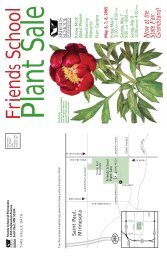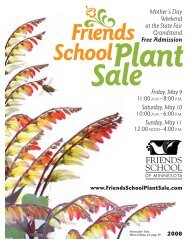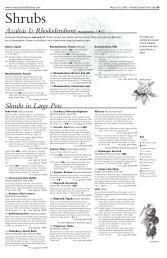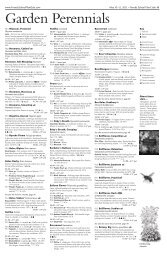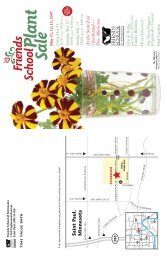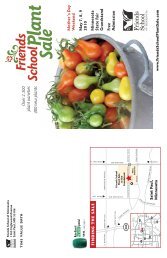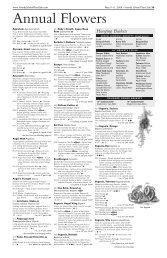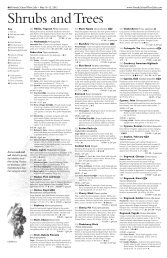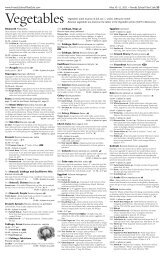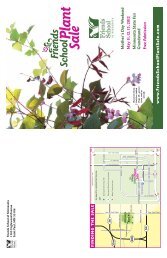The North Country Herbalist Guild - Friends School Plant Sale
The North Country Herbalist Guild - Friends School Plant Sale
The North Country Herbalist Guild - Friends School Plant Sale
Create successful ePaper yourself
Turn your PDF publications into a flip-book with our unique Google optimized e-Paper software.
www.<strong>Friends</strong><strong>School</strong><strong>Plant</strong><strong>Sale</strong>.com 2007 • <strong>Friends</strong> <strong>School</strong> <strong>Plant</strong> <strong>Sale</strong> 23<br />
Herbs<br />
H001 Aloe Aloe vera<br />
Succulent whose leaves are used to treat<br />
burns, poison ivy, and rashes. Annual, or bring<br />
indoors as a house plant. 12-24” Í∏ ¥<br />
—in a 2.5” pot $1.50<br />
Basil see box at right<br />
H021 Bay Laurel Laurus nobilis<br />
Bay leaves, the well-known seasoning. <strong>The</strong><br />
only tree (it’s small for a tree!) in our herb collection!<br />
Excellent container plant, spending<br />
the winter as a house or kitchen plant. It has<br />
long been popular for growing in tubs and<br />
large pots. If you bring it in to overwinter each<br />
year, it could grow pretty large. Í∏ÇÂ<br />
—in a 3.5” pot $8.00<br />
H022 Borage Borago officinalis ß<br />
Tiny blue and pink flowers, heavy flowering<br />
and attractive to bees. Large silver leaf. Young<br />
leaves good in salads. Annual, self-sows. 24”<br />
Í∏´Ç —in a 3.5” pot $2.50<br />
H023 Burnet, Salad Sanguisorba minor ß<br />
Attractive low-growing herb with serrated<br />
leaves. Brought from Europe by the Pilgrims<br />
and grown by Thomas Jefferson and Francis<br />
Bacon. Cucumber taste. Perennial. 9-24”<br />
ÍÇÂ —in a 3.5” pot $2.50<br />
H024 Caraway Carum carvi ß<br />
Two-foot feathery leaved biennial. Grown primarily<br />
for its seeds to season soups, stews,<br />
breads and pastries. Leaves are also edible.<br />
May self-sow. 24” ÍÇÂ<br />
—in a 3.5” pot $2.50<br />
H025 Catnip Nepeta cataria ß<br />
Leaves are euphoric for cats and<br />
mildly sedative for us. Good for<br />
salads and tea, vitamin C.<br />
Perennial, 12” spacing. 12-36”<br />
Í∏Ç —in a 2.5” pot $1.50<br />
H026 Chamomile, German<br />
Matricaria recutita ß<br />
Small white and yellow flowers<br />
with apple scent. Flowers make<br />
calming tea or bath. Dries well.<br />
Good in arrangements or potpourri.<br />
Annual, 12” spacing. 12-18”<br />
Í∏´Ç —in a 2.5” pot $1.50<br />
H027 Chamomile, Roman ß<br />
Chamaemelum nobile<br />
Roman chamomile originates in northwestern<br />
Europe and <strong>North</strong>ern Ireland, where it creeps<br />
close to the ground. Gray-green leaves grow<br />
from the stems, and the flowers have yellow<br />
centers surrounded by white petals, like miniature<br />
daisies. It differs from German chamomile<br />
in that its leaves are thicker and it grows closer<br />
to the ground. <strong>The</strong> flowers smell like apples.<br />
Dries well. 12” ÍÇÂ —in a 3.5” pot $2.50<br />
H028 Chives Allium schoenoprasum ß<br />
Widely used for soups, salads and stews. Easy<br />
to grow and once established lasts for years.<br />
Attracts butterflies. Divide every few years.<br />
Perennial. 12-24” Í∏˜´ÇÂ<br />
—in a 2.5” pot $1.50<br />
H029 Chives, Garlic Allium tuberosum ß<br />
Abundant white flowers in late summer, beautiful<br />
edible garnish. Flat leaves with fine flavor.<br />
Used in Chinese medicine for kidneys, lower<br />
back and knees. Perennial and reseeds readily.<br />
12-18” Í∏Ó´Ç —in a 2.5” pot $1.50<br />
H030 Chives, German<br />
Allium senescens ß<br />
Elegant, flat shiny 12” leaves may be used like<br />
chives. Topped by 18-20” stems with 2”<br />
spheres of lavender flowers July-September.<br />
Excellent in the flower border as well. 18-20”<br />
Í∏Ó´Ç —in a 2.5” pot $1.50<br />
H031 Cilantro Coriandrum sativum ß<br />
Flowers, leaves, roots and seed can all be used<br />
to flavor a wide variety of foods, especially<br />
Mexican and Thai dishes. Popular in salsa.<br />
Seed is coriander. Infusion of<br />
seeds is used as a digestive tonic<br />
and mild sedative. Annual. 24-36”<br />
ÍÇÂ —in a 2.5” pot $1.50<br />
Caraway<br />
H032 Dill, Bouquet ß<br />
Anethum graveolens ‘Bouquet’<br />
Leaves and seeds for vinegar, salad<br />
dressing, pickles, and dill dip.<br />
Leaves are sweeter, with a more<br />
refined taste. Wonderful as an airy<br />
filler in the garden; great for bouquets.<br />
Excellent for bees and caterpillars.<br />
Self-seeding annual.<br />
Attracts swallowtail butterflies.<br />
36” Í´ÇÂ<br />
—in a 2.5” pot $1.50<br />
Join us the 1st Wednesday of the month for:<br />
<strong>The</strong> <strong>North</strong> <strong>Country</strong><br />
<strong>Herbalist</strong> <strong>Guild</strong><br />
Featuring lectures, herb walks and more<br />
in a relaxed atmosphere to help you<br />
learn and grow.<br />
Meetings are held at<br />
Bethany Lutheran Church<br />
2511 East Franklin Ave.<br />
Minneapolis<br />
Basil Ocimum Í´ÇÂ<br />
Cooks and even regular gardeners can’t have enough basil. <strong>The</strong>se annual plants<br />
are native to sunny, warm Mediterranean climes and will not withstand frost.<br />
H002 African Blue ß<br />
Ornamental herb with showy purple flowers. Big and bushy—a real<br />
visual (and edible) treat. To 36” ç —in a 3.5” pot $2.50<br />
H003 Ararat ◊<br />
Unique appearance with mottled green and purple leaves. Mild,<br />
classic basil flavor. This versatile basil can be used as a garnish, a<br />
filler in fresh bouquets, or a dramatic focal point in ornamental<br />
gardens. 20–28” ç —four plants in a pack $3.00<br />
H004 Cinnamon Ocimum basilicum ß<br />
Dark green leaves and dark purple flowers. Sharp cinnamon aroma,<br />
wonderful fragrance. Narrower leaves with purple stems. Finest tea<br />
basil, good in fruit salads. 12–24” ç<br />
—four plants in a pack $3.00<br />
H005 Fino Verde ß<br />
Greek mouse ear type. Very attractive, compact basil that forms a<br />
rounded mound. 6-8” —four plants in a pack $3.00<br />
H006 Greek Columnar ß<br />
Wonderful columnar form of culinary basil. Slow to flower. 24-36”<br />
—in a 3.5” pot $2.50<br />
H007 Lemon Ocimum basilicum citriodorum ß<br />
Delicious small-leaf variety combines flavors of lemon and basil.<br />
Good for tea, pesto, salads and dressings. 12” spacing. 12-24”<br />
—four plants in a pack $3.00<br />
H008 Lime Ocimum americanum ß<br />
Dark green leaves with lime fragrance. 12”<br />
—four plants in a pack $3.00<br />
H009 Magic Michael ß<br />
All-America selection. Purple bracts and small creamy white flowers.<br />
Great foliage in a mixed container. 12-18” ç<br />
—four plants in a pack $3.00<br />
H010 Mammoth Ocimum basilicum ß<br />
Lettuce-leaf type with very large ruffled leaves, especially suitable<br />
for drying or stuffing. Flavor similar to sweet basil. 12-24”<br />
—four plants in a pack $3.00<br />
H011 Minette ß<br />
Also called Dwarf Fine Bush Basil. Pretty enough to edge the garden,<br />
this mini-basil is also delicious. Minette is one of the most<br />
eye-catching basils you will ever see, creating perfect 10-inch<br />
spheres of bright green that stay compact and uniform all season.<br />
10” —four plants in a pack $3.00<br />
H012 Mixed Four-Pack ß<br />
One each of Sweet, Lemon, Spicy Globe and Thai Siam Queen.<br />
—four plants in a pack $3.00<br />
H013 Napoletano ß<br />
Heirloom variety from Italy with light green crinkled leaves. To 36”<br />
—four plants in a pack $3.00<br />
H014 Opal ß<br />
Purple leaves. Anise flavor. 12-36” ç —four plants in a pack $3.00<br />
H015 Oriental Breeze ß<br />
A basil bred for cut flower and container usage. Very floriferous and<br />
fragrant. 4-6” long flower heads are white with purple bracts. 12-<br />
18” —four plants in a pack $3.00<br />
H016 Pesto Perpetuo ß◊<br />
Variegated leaves, green with a creamy white edge. Does not flower.<br />
Columnar habit. A great culinary basil with a slightly lemon flavor.<br />
18-36” ç —in a 3.5” pot $2.50<br />
H017 Red Rubin ß<br />
Large-leaved purple version of Italian Large basil. 18-24” ç<br />
—four plants in a pack $3.00<br />
H018 Spicy Globe Ocimum basilicum minimum ß<br />
<strong>The</strong> “good basil” of French cuisine. Dwarf version of sweet basil.<br />
Lower and smaller in all of its parts, it makes a sweet edging plant.<br />
12” —four plants in a pack $3.00<br />
H019 Sweet Ocimum basilicum ‘Genovese’ ß<br />
Prolific and popular. Wonderful for pesto, tomato dishes and salads.<br />
<strong>Plant</strong> any of the basils where they will be brushed against to release<br />
the scent. 21” —four plants in a pack $3.00<br />
H020 Thai ‘Siam Queen’ ß<br />
Huge green leaves contrast nicely with purple stems.<br />
Recommended as an ornamental. Thicker and sturdier than standard<br />
basil. Outstanding fragrance and flavor—sweet and spicy with<br />
anise overtones. Used in Asian cooking. 28–39" ç<br />
—four plants in a pack $3.00<br />
www.nchg.org<br />
612-827-2570
24 <strong>Friends</strong> <strong>School</strong> <strong>Plant</strong> <strong>Sale</strong> • 2007<br />
Herbs<br />
www.<strong>Friends</strong><strong>School</strong><strong>Plant</strong><strong>Sale</strong>.com<br />
We accept cash, checks,<br />
Visa and MasterCard<br />
Key<br />
Í Full sun<br />
∏ Part sun/part shade<br />
Ó Shade<br />
˜ Minnesota native<br />
å U.S. native<br />
˝ Ground cover<br />
‰ Rock garden<br />
ç Attractive foliage<br />
´ Edible flowers<br />
 Medicinal<br />
Ç Culinary<br />
ß Saturday restock<br />
¥ Toxic to humans<br />
Find me at<br />
the <strong>Plant</strong> <strong>Sale</strong>.<br />
I’ll be in several<br />
colors for $35<br />
Fennel Foeniculum vulgare ß<br />
Sweet anise-like flavor. Bulbous base can be<br />
cooked as a vegetable. Leaves and seeds are<br />
used to flavor soups, salads, sauces, cookies<br />
and fish. Hardy biennial. 12” spacing. 24-48”<br />
Í´ÇÂ<br />
H033 ß —in a 2.5” pot $1.50<br />
H034 Zefa Fino ß—Lovely form in the garden.<br />
Resists bolting. 12” —in a 3.5” pot $2.50<br />
Geranium, Scented Pelargonium spp.<br />
<strong>The</strong>se grow well in containers. Colorful flowers.<br />
Delicious fragrances. Bring indoors for<br />
winter. 12-24” Í´<br />
H035 Apricot ß—Small round crinkly leaves<br />
grown for bright pink flowers with white<br />
inner highlights. Soft apricot fragrance.<br />
H036 Strawberry ß—Small crisp leaves with a<br />
pleasant strawberry scent. Compact.<br />
—in a 4.5” pot $5.00<br />
H037 Horseradish Armoracia rusticana<br />
Spicy root used as a condiment. Likes rich<br />
soil for the most pungent roots (amend<br />
with compost or fertilizer before planting).<br />
If you plan to heavily harvest the<br />
roots, plant in the ground, but otherwise<br />
best in a container, which can be set into<br />
the ground if you prefer. Perennial. 36”<br />
Í∏Ç —bare root in the Lily Shop $2.00<br />
Lavender see page 25<br />
H038 Lavender Cotton<br />
Santolina chamaecyparissus<br />
Ferny gray foliage that’s very fragrant and<br />
makes good edging. Attractive yellow buttonshaped<br />
flowers that add nicely to arrangements,<br />
and can be cooked into a brilliant<br />
yellow dye. Drought tolerant. Annual. 6”<br />
ÍÇÂ —in a 3.5” pot $2.50<br />
H052 Lemon Balm Melissa officinalis ß<br />
Aromatic sweet herb of the Mint family. Leaves<br />
have a strong lemon odor and flavor. Makes a<br />
refreshing ice tea. Grown in the herb garden for<br />
seasoning breads and desserts. Also used in<br />
liqueurs and for medicine. Used for colds, flu,<br />
depression, headache and indigestion. Small 2-<br />
lipped flowers in late summer. Old world origin<br />
but naturalizes. Mulch for winter protection.<br />
Excellent for bees. Perennial. 24” Í∏ÇÂ<br />
—in a 2.5” pot $1.50<br />
H053 Lemon Grass Cymbopogon citratus<br />
Leaves used in Asian cooking and in teas. It is<br />
frost tender and should be taken inside for the<br />
winter. Best in containers; winter indoors.<br />
Repels mosquitos. 60” ÍÇÂ<br />
—in a 2.5” pot $3.00<br />
H054 Lovage Levisticum officinale ß<br />
Leaves have a strong celery taste and are used<br />
to flavor soups, stews and casseroles. Formerly<br />
used to mask the taste in bitter medicinal concoctions.<br />
Has been used as a love charm.<br />
Flowers in umbels. Perennial. 36-72”<br />
Í∏Ç —in a 3.5” pot $2.50<br />
H055 Marjoram, Sweet Origanum ß<br />
Tastes like mild oregano. Used in vinegars,<br />
soups and dressings. Add fresh leaves to salads.<br />
Good herbal bath. Excellent for bees. Not<br />
hardy in Minnesota. 18” Í∏´ÇÂ<br />
—in a 2.5” pot $1.50<br />
H056 Mint, Chocolate ß<br />
Mentha x piperita<br />
Bronzy foliage with a chocolate scent.<br />
Perennial. 24” Í∏Ç —in a 3.5” pot $2.50<br />
H057 Mint, Corsican Mentha requienii ß<br />
Creeping fragrant perennial. Good in rock gardens<br />
and along paths. Tolerates light foot traffic.<br />
May survive our winters. 0.5”<br />
Í∏Ólj˝ —in a 3.5” pot $2.50<br />
H058 Mint, Grapefruit<br />
Mentha aquatica citrata<br />
Large puckered leaves and the scent of grapefruit.<br />
Perennial, 18” Í∏Ç<br />
—in a 2.5” pot $1.50<br />
H059 Mint, Lemon Monarda citriodora ß<br />
Lemon-scented leaves are delicious, and often<br />
used in teas. Tiered pinkish-purple showy<br />
flowers are long lasting in fresh bouquets and<br />
can be dried as an everlasting. Inhale steam for<br />
colds. Native to Appalachia. Annual. 24-36”<br />
Í∏ÇÂå —in a 3.5” pot $2.50<br />
H060 Mint, Orange<br />
Mentha aquatica citrata<br />
Perennial. 12-36” Í∏Ç—in a 3.5” pot $2.50<br />
H061 Mint, Peppermint ß<br />
Mentha x piperita<br />
Refreshing tea, iced or hot. Good in fruit salads.<br />
Easily dried for year-round use. Excellent<br />
for bees. Perennial, 12” spacing. 24” Í∏ÇÂ<br />
—in a 2.5” pot $1.50<br />
H062 Mint, Pineapple<br />
Mentha suaveolens variegata<br />
Variegated leaves. Easily cultivated. For teas<br />
and potpourris. Perennial. 24-36” Í∏Ç<br />
—in a 3.5” pot $2.50<br />
<strong>The</strong> Medicine Garden<br />
<strong>The</strong>re are many types of gardens. My own<br />
gardening journey has been with herbs<br />
I have grown for medicine, for myself<br />
and my loved ones. In addition to the healing<br />
properties of the plants, I have learned about<br />
the healing that comes from being in relationship<br />
with nature.<br />
I began to study herbal medicine almost 20<br />
years ago and taught myself to identify the<br />
plants. Slowly I began to harvest them, learning<br />
each one at a time. I have been blessed by wonderful<br />
teachers, all of whom have helped me<br />
deepen my relationships with the plants, yet<br />
none has taught me more than the plants<br />
themselves.<br />
As with any garden, if you pay attention, the<br />
plants will “teach” you. Additionally, whether<br />
you learn from your neighbor who grows herbs,<br />
an herbalist in your area, or a good-quality<br />
book, you will also want to learn from others’<br />
experiences. With a little wonder and a little<br />
research, one can safely explore this empowering<br />
form of self-care.<br />
<strong>The</strong> <strong>Friends</strong> <strong>School</strong> <strong>Plant</strong> <strong>Sale</strong> has many<br />
medicinal plants available for your garden. This<br />
year’s catalog takes even greater care to identify<br />
medicinal plants and those that are potentially<br />
toxic. Again this year, the <strong>North</strong> <strong>Country</strong><br />
<strong>Herbalist</strong> <strong>Guild</strong> will have a table at the plant<br />
sale, with herbalists on hand to answer questions.<br />
Stop by to learn more about resources<br />
and education in your area.<br />
Two of my personal favorite book resources are<br />
Rosemary Gladstar’s Family Herbal, and <strong>The</strong> New<br />
Holistic Herbal by David Hoffmann. Rosemary’s<br />
book is for the family/community herbalist<br />
and is filled with wonderful, fun recipes, while<br />
David’s is a classic on the fundamentals of herbal<br />
medicine. <strong>The</strong> Book of Herbal Wisdom, by<br />
Minnesota’s own Matthew Wood, is indispensable<br />
for the more advanced herbal student.<br />
Using these resources and following a few<br />
simple guidelines will allow you to use the<br />
plants to your and your family’s benefit. Identify<br />
the herbs you want to grow, the parts of the<br />
plant that are used, and for what purposes.<br />
Tonic herbs, including lemon balm, coneflower<br />
(Echinacea), and chamomile, are some of the<br />
safest plants to use. Stronger medicine plants,<br />
such as boneset and black cohosh, are generally<br />
used for shorter periods of time and/or in<br />
smaller doses. If you have a health condition or<br />
are taking medication, check with a qualified<br />
herbalist and your primary care provider before<br />
trying new herbs. Some herb/drug combinations<br />
can be deadly.<br />
Once you’ve identified the plant parts, let<br />
nature be your guide. If the leaves are used,<br />
harvest them before the plant flowers in the<br />
spring. Flowers are harvested in full bloom, and<br />
seeds are harvested when they are ripe. Roots<br />
are usually dug in the fall. Follow the plant’s<br />
lead—wherever it is putting its energy, that’s<br />
where the medicine will be. Listen to the plants,<br />
let them guide you, and whether you are gardening<br />
for personal healing or family wellness,<br />
enjoy sinking your own roots down and<br />
receiving the healing power of nature.<br />
—Cynthia Thomas<br />
Cynthia Thomas, herbalist, BS, NCTMB, is a<br />
practicing herbalist and educator, massage therapist,<br />
and doula (childbirth assistant) serving the Twin Cities<br />
area. She has been working with medicinal herbs for<br />
over 15 years and has a BS in Herbal Sciences from<br />
Bastyr University. In addition, she has served seven<br />
years on the Board of Directors for the <strong>North</strong> <strong>Country</strong><br />
<strong>Herbalist</strong> <strong>Guild</strong>, a local nonprofit providing education<br />
and resources for the ethical and sustainable use of<br />
medicinal plants. cynthia_thomas@mac.com
www.<strong>Friends</strong><strong>School</strong><strong>Plant</strong><strong>Sale</strong>.com 2007 • <strong>Friends</strong> <strong>School</strong> <strong>Plant</strong> <strong>Sale</strong> 25<br />
Herbs<br />
Using Sorrel<br />
Sorrel is a delicately aciduous<br />
herb, little known in the U.S.<br />
Most refreshing in summer,<br />
you can use it for salads,<br />
soups and seasoning, or even<br />
as a vegetable.<br />
You can add chopped sorrel to<br />
lentil soup, or add a handful<br />
of sorrel, wilted in butter for<br />
five minutes, to an omelette.<br />
Or try this cool summer<br />
soup from James Beard’s<br />
<strong>The</strong> Fireside Cookbook.<br />
—Carol<br />
H063 Mint, Spearmint<br />
Mentha spicata ß<br />
Softer flavor than peppermint. Great for teas,<br />
meat, fish, fruit and vegetables. Will deter<br />
aphids in rose beds. Excellent for bees.<br />
Perennial, 12” spacing. 24” Í∏ÇÂ<br />
—in a 2.5” pot $1.50<br />
H064 Mixed Herbs<br />
One each of of sage, thyme, oregano and basil.<br />
ØÍ —four plants in a pack $2.50<br />
H065 Onion, Egyptian Walking<br />
Allium cepa ‘Proliferum’<br />
A non-flowering onion that produces small<br />
clusters of reddish, marble-sized bulbs (bulbils)<br />
at the tops of the leaves. As these bulbils<br />
increase in size and weight the leaves bend to<br />
the ground and the bulbils take root. This<br />
allows the plant to “walk” around the garden.<br />
<strong>The</strong> tops, underground bulbs, and bulbils are all<br />
edible. However, many people prefer to eat only<br />
the green tops and immature bulbils because<br />
both the bulbs and mature bulbils can be very<br />
pungent. Perennial. 18-24” Í<br />
—in a 2.5” pot $1.50<br />
Oregano Origanum vulgare<br />
Essential for Italian cooking. Leaves can be<br />
used fresh or dried in tomato sauces, meat,<br />
fish and salads.Perennial. Í∏ÇÂ<br />
H066 O. vulgare ß—12-36”<br />
—in a 2.5” pot $1.50<br />
H067 Santa Cruz ß—Showy variety with compact<br />
hop-like rosy flowers and dark green<br />
foliage. 10” —in a 3.5” pot $2.50<br />
H068 Oregano, Mexican ß<br />
Labiatae poliomintha longiflora ◊<br />
Shrub-like plant with pale green leaves and a<br />
unique peppery flavor. Grows large quickly.<br />
Deer resistant annual with light pink tubular<br />
flowers, beloved of hummingbirds. Annual.<br />
36” ÍÇ —in a 3.5” pot $2.50<br />
Parsley, Curly Petroselinum hortense<br />
Quintessential garnish, chock full of vitamins.<br />
Promotes healthy skin. Can be chewed to<br />
freshen breath. Dig one up in the fall and pot<br />
for fresh greens in the winter. Biennial. 6”<br />
spacing. 12” Í∏ÇÂ<br />
H069 ß —in a 2.5” pot $1.50<br />
H070 Ø —four plants in a pack $2.50<br />
Parsley, Italian Petroselinum hortense<br />
Flat-leaved, with stronger flavor. 12” Í∏ÇÂ<br />
H071 ß —in a 2.5” pot $1.50<br />
H072 Ø —four plants in a pack $2.50<br />
H073 Patchouli Pogostemon heyneanus ß<br />
Tropical native to the East Indies. Used for the<br />
fragrance of the dried leaves. 12” Í<br />
—in a 3.5” pot $2.50<br />
H074 Pennyroyal Mentha pulegium ß<br />
Known for its insect-repelling properties.<br />
Makes a potent tea, but be aware that it should<br />
not be used during pregnancy. <strong>The</strong> plants<br />
creep with only the lavender flower stalks<br />
rising above the ground. Perennial; mulch for<br />
winter protection. 4-16” Í∏˝Â¥<br />
—in a 3.5” pot $2.50<br />
Beet and Sorrel Soup<br />
3–4 young beets<br />
2 cups chicken broth<br />
1 teaspoon salt<br />
2 cups sorrel<br />
2 tablespoons butter<br />
1/2 cup chicken broth<br />
Sour cream<br />
Scallions, sliced<br />
Cucumber, sliced<br />
Chopped hard-cooked egg<br />
Peel and slice or dice the<br />
beets. Cook in the broth with<br />
salt. Wash and chop the sorrel,<br />
then wilt it in butter in a<br />
skillet, add the 1/2 cup of<br />
broth and cook until tender.<br />
Combine sorrel and beets and<br />
puree. Chill. Serve cold with<br />
sour cream, scallions,<br />
cucumber and eggs.<br />
H075 Red Shiso Perilla frutescens crispa ß<br />
Very ornamental purplish-red cinnamon-scented<br />
leaves are used in Japanese and Vietnamese<br />
cuisine in sushi and spring rolls, sauces,<br />
salads, stir fry. Large ruffled purple leaves. A<br />
beautiful container accent. Reseeding annual;<br />
seedlings emerge in June. 24-36” Í∏´Ç<br />
—six plants in a pack $4.00<br />
Rosemary Rosmarinus officinalis<br />
Enhances many meat and veggie dishes, vinegars<br />
and dressings. Use for a refreshing bath<br />
or hair rinse. Perennial in warmer zones; here<br />
you‘ll need to winter it indoors. ÍÇÂ<br />
H076 Seed-grown ß—12”—in a 2.5” pot $1.50<br />
H077 Mrs. Howard’s ß—Fast-growing and<br />
creeping—great for bonsai! Culinary and<br />
ornamental. 8”<br />
H078 Prostrate—low growing ß—6”<br />
H079 Spice Island ß—24-36”<br />
H080 Tuscan Blue ß—36” —in a 3.5” pot $2.50<br />
H081 R. officinalis, large pot ß—12”<br />
—in a 1 gal. pot $8.00<br />
Sage, Culinary Salvia officinalis<br />
Used traditionally in poultry stuffing and<br />
sausage. Wonderful in salads, egg dishes,<br />
breads and vegetable dishes. Sage is used to<br />
freshen breath, as a nerve tonic and digestive.<br />
Dried leaves among linens discourages insects.<br />
Excellent for bees. Perennial, but not reliable<br />
here. 20” spacing. Í´ÇÂ<br />
H082 Common ß—24” —in a 2.5” pot $1.50<br />
H083 Berggarten ß—Broad leaves with silver<br />
accents, ornamental. Good flavor. Very<br />
hardy. 18”<br />
H084 Pineapple ß—Sweet pineapple scent<br />
with red flowers. Blooms all season. 48”<br />
H085 Purple ß—Blush leaves and flowers,<br />
lovely in containers. 24-36”<br />
H086 Tricolor ß—Green, pink and white<br />
foliage. Very attractive. 15”<br />
—in a 3.5” pot $2.50<br />
H087 Sorrel, French Rumex scutatus ß<br />
Early season greens with tangy lemon flavor.<br />
Long-lived perennial that can sustain frequent<br />
and severe cutting. Everyone should have<br />
some! Great in soup or salad. 24” ÍÇÂ<br />
—in a 2.5” pot $1.50<br />
H088 Spikenard, American<br />
Aralia racemosa<br />
Stately white plumes followed by clusters of<br />
black berries. Roots used in rootbeer and medicinally.<br />
36-60” Í∏ —in a 3.5” pot $5.00<br />
H089 Stevia Stevia rebaudiana ß<br />
Sweeter than sugar! <strong>The</strong> South American herb<br />
you‘ve been reading about as a sugar replacement.<br />
12” Í∏Ç —in a 3.5” pot $2.50<br />
H090 Sweet Annie ß<br />
Artemisia annua ‘Sweet Annie’<br />
This fast growing annual herb has a fabulous<br />
fragrance. Although tall, it has a fern-like<br />
foliage. Great for making scented wreaths or<br />
potpourri. Re-seeds heavily. Native to<br />
Ethiopia, it is the recently discovered source of<br />
a new treatment for malaria. 48” ÍÂ<br />
—in a 2.5” pot $1.50<br />
H091 Tarragon, French ß<br />
Artemisia dranunculus<br />
Strong tasting herb. Good in vinegar. Root can<br />
be potted in late fall for winter windowsill use.<br />
36” ÍÇÂ —in a 3.5” pot $2.50<br />
Lavender Í´ÇÂ Lavandula<br />
Everyone loves lavender! Tender perennial from southern Europe. Only<br />
one variety is reliably winter-hardy in Minnesota; others can be wintered<br />
indoors or treated as annuals.<br />
H039 Fern-leaf ß<br />
Annual variety with unique foliage. 36”<br />
Thyme Thymus vulgaris<br />
Bushy, cushion-forming sub-shrub. Small<br />
leaves and wiry structure. Ornamental as well<br />
as culinary and soothing tea. Easy to grow.<br />
Very hardy. Excellent for butterflies and bees.<br />
Used medicinally for sore throats and coughs.<br />
Good potted. Perennial. ÍÇÂ<br />
H092 English ß—6” —in a 2.5” pot $1.50<br />
H093 Caraway ß—6”<br />
H094 English Miniature ß—Very tiny leaves.<br />
forms a thick, spreading patch of medium<br />
green. 1-3”<br />
H095 French ß—10”<br />
H096 Gold Lemon ß—6”<br />
H097 Lime ß—Bright green foliage, similar to<br />
lemon thyme. Pink flowers, citrus scent.<br />
Hardy. 6-12”<br />
H098 Silver Edge ß—Narrow-leaved with silver-gray<br />
foliage. Compact and great for<br />
containers. 4”<br />
H099 Silver Posie ß—White-margined leaves.<br />
10”<br />
H100 Wedgewood ß—Light green leaf with<br />
dark green edge. 8” —in a 3.5” pot $2.50<br />
—See also Creeping, Miniature<br />
and Woolly Thyme, page 45<br />
H101 Verbena, Lemon<br />
Aloysia triphylla ß<br />
Tender perennial; can be potted and wintered<br />
inside. Wonderfully fragrant lemony herb.<br />
Light green pointed leaves. Great for topiaries.<br />
36” ÍÂ —in a 3.5” pot $2.50<br />
—in a 3.5” pot $2.50<br />
H040 French ß<br />
Lavender of the French countryside. Upright gray foliage.<br />
24-36” —in a 3.5” pot $2.50<br />
H041 Goodwin Creek ß<br />
Unusual light-gray-green foliage with a thick, coarse, appealing<br />
texture. 24-36” —in a 3.5” pot $2.50<br />
H042 Lady Lavandula angustifolia ß<br />
A fine annual variety, blooms this year. Smells good in the garden<br />
and in sachets and potpourris. Good for bees. 8-10”<br />
—in a 2.5” pot $1.50<br />
Munstead Lavandula angustifolia ‘Munstead’<br />
English lavender. Excellent landscaping variety. Lowest growing<br />
lavender, good for edging a path or border. Fragrant foliage and<br />
flowers. <strong>The</strong> most reliably hardy lavender for our climate. 12-18”<br />
H043 ß —in a 2.5” pot $1.50<br />
H044 ß —in a 3.5” pot $2.50<br />
H045 Provence Lavandula x intermedia ß<br />
When you travel to the French countryside, where lavender is<br />
grown commercially for oil and flowers, this is one of the cultivars<br />
you will find. <strong>The</strong> light purple flowers are very fragrant, and<br />
dry beautifully for potpourri. More moisture tolerant than other<br />
varieties. 24-36” —in a 3.5” pot $2.50<br />
H046 Silver Edge Lavandula angustifolia ß<br />
Variegated foliage with blue-green centers and creamy margins.<br />
Blue blooms. 18” —in a 3.5” pot $2.50<br />
Spanish Lavandula stoechas<br />
Fast-growing with cool purple flowers. Not winter hardy, but a<br />
candidate for pot culture. Can be grown as an annual.<br />
H047 Kew Red ◊ß—Red-violet blooms add a new color to the<br />
Lavender species. Very decorative for edging and containers.<br />
18”<br />
H048 Otto Quast ß—Bold, purple-bracted flower spikes. A softer<br />
fragrance than other lavenders. Repeat bloomer, especially<br />
with deadheading. 24-36”<br />
H049 Passione ß—Compact with dark flower spikes topped by<br />
burgundy-purple bracts like bunny ears. Lush green foliage.<br />
16-20” —in a 3.5” pot $2.50<br />
H050 Sweet ß<br />
One of the most productive and fragrant lavenders. Sturdy,<br />
straight stems. One of the tallest lavenders. 36-48”<br />
—in a 3.5” pot $2.50<br />
H051 Twickel Purple<br />
Compact, bushy plant with purple flowers. 24”<br />
—in a 2.5” pot $1.50<br />
Stevia





